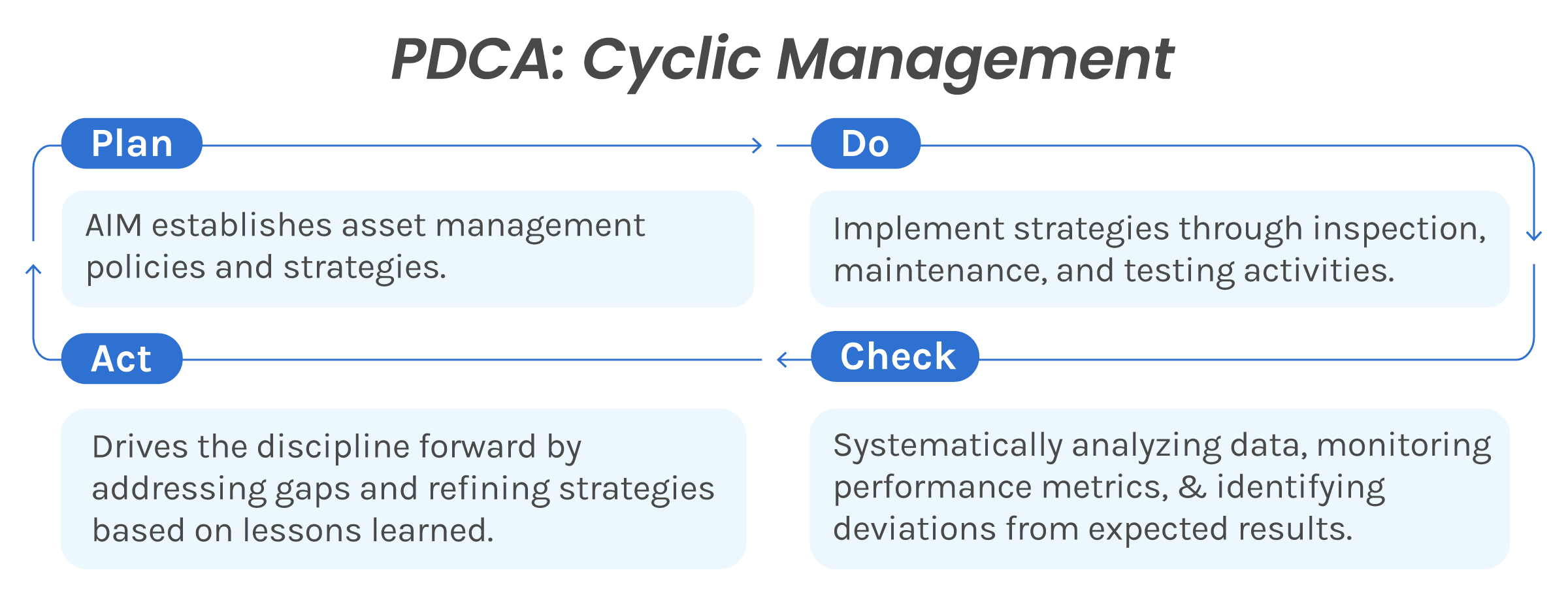Asset Integrity Management (AIM) is a fundamental domain for large-process industries. It refers to the discipline that aims to maximize a production plant’s efficiency and reliability, involving multiple methodologies, systems, and various professionals and activities. This blog dives into how industry leaders approach AIM, encompassing a step-by-step structure to implement a robust program. Nonetheless, before understanding the current state of AIM, how did it evolve to such a complex and specific area?
What is Asset Integrity Management?
Asset Integrity Management (AIM) is the systematic approach to ensure the safety, reliability, and efficiency of industrial assets throughout their lifecycle. It integrates policies, procedures, and technologies to prevent failures, reduce risks, and maintain compliance with regulatory and operational standards. By combining proactive planning, real-time monitoring, and data-driven decision-making, AIM enhances operational performance, extends asset lifespan, and safeguards people, the environment, and business continuity.
Over time, the concept of AIM has evolved, gaining new significance in this interconnected era. Today, as in its historical origins, AIM represents a multidisciplinary field shaped by the need for situational adaptability. Just as its principles have adapted, AIM mirrors frameworks like the PDCA cycle, emphasizing its cyclic nature through continuous improvement to enhance safety and efficiency in industrial operations.
Plan-Do-Check-Act (PDCA): Cyclic Management 101
The Plan-Do-Check-Act (PDCA) cycle is a foundational framework for continuous improvement, widely applied across industries to enhance processes and achieve better outcomes. It begins with planning, where objectives are defined and strategies are formulated, followed by implementation in the “Do” phase. The “Check” phase involves evaluating results and identifying areas for improvement, leading to the “Act” phase, where adjustments are made to refine the process.

In this sense, modern Asset Integrity Management (AIM) aligns closely with the principles of the PDCA cycle, emphasizing continuous improvement as its cornerstone. In the ‘’Plan’’ phase, AIM establishes asset management policies and strategies. This includes defining objectives based on previous records such as risk assessments, shutdown and turnaround data, inspection reports, and integrity documents, helping to structure comprehensive plans that align safety with operational goals. These steps mirror the strategic groundwork necessary to ensure robust performance assurance and risk control.
The execution, or “Do” phase, corresponds to implementing these strategies through inspection, maintenance, and testing activities. The objective is to conduct operational initiatives that translate plans into measurable actions, ensuring adherence to safety standards and operational benchmarks. Temporary repairs, non-destructive testing, and coating plans are examples of activities that can be performed during this phase.
Next, the “Check” phase within AIM evaluates the outcomes of these interventions by systematically analyzing data, monitoring performance metrics, and identifying deviations from expected results. Key Performance Indicators (KPIs), such as corrosion state, risk ranking according to severity and criticality, and surface degradation, are used to measure the effectiveness of implemented strategies. Additionally, this phase ensures that all activities comply with regulatory requirements and industry standards, safeguarding both operational integrity and legal accountability.
Finally, the “Act” phase drives the discipline forward by addressing gaps and refining strategies based on lessons learned. This involves updating asset management policies, revising maintenance schedules, and incorporating new technologies or methodologies to enhance future performance. Feedback from the “Check” phase is crucial in this step, as it informs decisions that improve efficiency, reduce risks, and ensure compliance. By integrating insights into a new edition of the PDCA cycle, AIM fosters a proactive approach to asset integrity, enabling industries to foresee evolving challenges. Besides that, aligning Asset Integrity Management (AIM) and the PDCA cycle is central to achieving ISO 55000 certification, the international standard for asset management systems.
ISO 55000

Developed by the International Organization for Standardization (ISO), the ISO 55000 standard emphasizes the systematic, risk-based, and continuous improvement approach that the PDCA cycle embodies, requiring industries to establish clear policies, implement robust management plans, and continuously monitor and improve their processes. Beyond that, ISO 55000 provides a solid basis for evidence-based decision-making, taking into account technical, financial, and operational aspects. In these conditions, to leverage the full potential of the cyclic AIM approach, the following step-by-step structure can be followed:
Step-by-step Asset Integrity Management
Establishing an effective Asset Integrity Management (AIM) program requires a structured and methodical approach. The following step-by-step framework explores the core components of AIM and their interconnections:

Stage 1: Foundation systems
Foundation systems form the backbone of an AIM program, providing the structure and resources necessary for its successful implementation. This phase involves the development and alignment of key elements such as:
- Policies and Standards: Establishing comprehensive asset management policies and standards ensures that consistent principles guide all actions. Industries often adhere to existing policies and standards, as they are required by regulatory institutions, ensuring alignment with industry-wide safety and operational benchmarks;
- Procedures and Guidelines: Defining clear procedures for operations, inspections, and maintenance activities creates a standardized approach that minimizes errors and variability;
- Multiple Team Allocation and Training: Properly allocating teams with specialized expertise across various domains is crucial for implementing AIM strategies. Additionally, robust training programs equip personnel with the necessary knowledge and skills to perform their tasks effectively;
- Technological Frameworks: Implementing digital tools, such as asset management software, data collection systems, and predictive analytics, enhances visibility and control over the AIM process.

Stage 2: Measurement actions
Measurement actions are the analytical and diagnostic steps that assess the current state of assets and predict potential risks. These actions provide the data-driven insights needed to guide decision-making and prioritize activities.
- Integrity Assessments: Regular evaluations of structural and mechanical integrity help identify wear, corrosion, or damage that could compromise safety and functionality;
- Risk Assessments: Conducting detailed risk analyses, such as Failure Mode and Effects Analysis (FMEA) or Preliminary Risk Analysis (PRA), supports the identification of potential threats and ranks them by severity and criticality;
- Reliability Metrics: Monitoring key performance indicators (KPIs) like Mean Time Between Failures (MTBF) and Mean Time to Repair (MTTR) provides insights into asset reliability and maintenance efficiency;
- Compliance Audits: Ensuring adherence to industry standards, regulatory requirements, and ISO 55000 guidelines protects organizations from legal and operational risks.

Stage 3: On-field activities
On-field activities are the practical execution steps that translate AIM strategies into tangible actions. These activities are essential for maintaining and restoring asset integrity in real-world settings.
- Inspection Programs: Routine inspections using non-destructive testing (NDT) techniques such as visual inspections, CVI, GVI, ultrasonic and x-ray testing, radiography, or thermography detect flaws and degradation during operations;
- Maintenance Activities: Both preventive and corrective maintenance are conducted to address wear and tear or repair unexpected failures. Predictive maintenance, driven by real-time data, further optimizes efficiency by anticipating issues before they occur;
- Testing Procedures: Functional and performance tests verify that equipment meets operational and safety standards. Examples include pressure testing, leak detection, and system load testing;
- Temporary Repairs: In cases where immediate fixes are required, temporary measures ensure continued operations until permanent solutions can be implemented;
- Coating and Corrosion Protection: Applying protective coatings and managing cathodic protection systems prevent material degradation and extend asset lifespan.

Challenges of implementing an AIM program
Implementing an effective Asset Integrity Management program presents several challenges, primarily due to the need to balance performance, risk, and costs. This delicate equilibrium is essential for optimizing investment, time, and resource allocation, ensuring the longevity of industrial assets. However, intricate process complexities, aging infrastructure, and evolving regulatory requirements often disrupt this balance. Thus, what are the main challenges facing the implementation of an AIM program?
Limitations of Traditional Inspection Methods
Visual inspections play a pivotal role in identifying wear, cracks, corrosion, or anomalies that could lead to asset failures and operational accidents. However, traditional methods depend on infield surveys, lacking efficiency and precision for accurate monitoring, which intensifies the turnover of the inspection and maintenance cycle, increasing the risk of undetected failures, which could lead to costly interruptions in operations. Additionally, different anomalies might look similar at human sight, requiring proper classification according to their behavior and characteristics, which complicates even further the anomaly reporting process.
Integration of Disparate Data Sources
Another significant challenge is the integration of diverse data sources. Industrial facilities rely on various systems for data collection and storage. This data is often unstructured, unprocessed, untreated, and presented in various forms as spreadsheets, reports, on-premises systems, or cloud systems. Without effective integration, critical information remains siloed, delaying decision-making and reducing operational efficiency. According to The Journal of Petroleum Technology, 80% of employee time in the offshore industry is spent looking through unstructured data to inform decisions.
Conclusion
Asset Integrity Management (AIM) is a vital framework for ensuring safety, reliability, and efficiency across large-process industries. Organizations can proactively address operational challenges while meeting regulatory and performance standards by integrating robust foundational systems, leveraging precise measurement actions, and executing directed on-field activities. AIM’s systematic approach fosters adaptability and continuous improvement, enabling industries to safeguard their assets, optimize processes, and align with the sustainability and technological advancement growing demands.
Interested in a 15-minute talk on how we can take your integrity strategy further? Fill the forms


